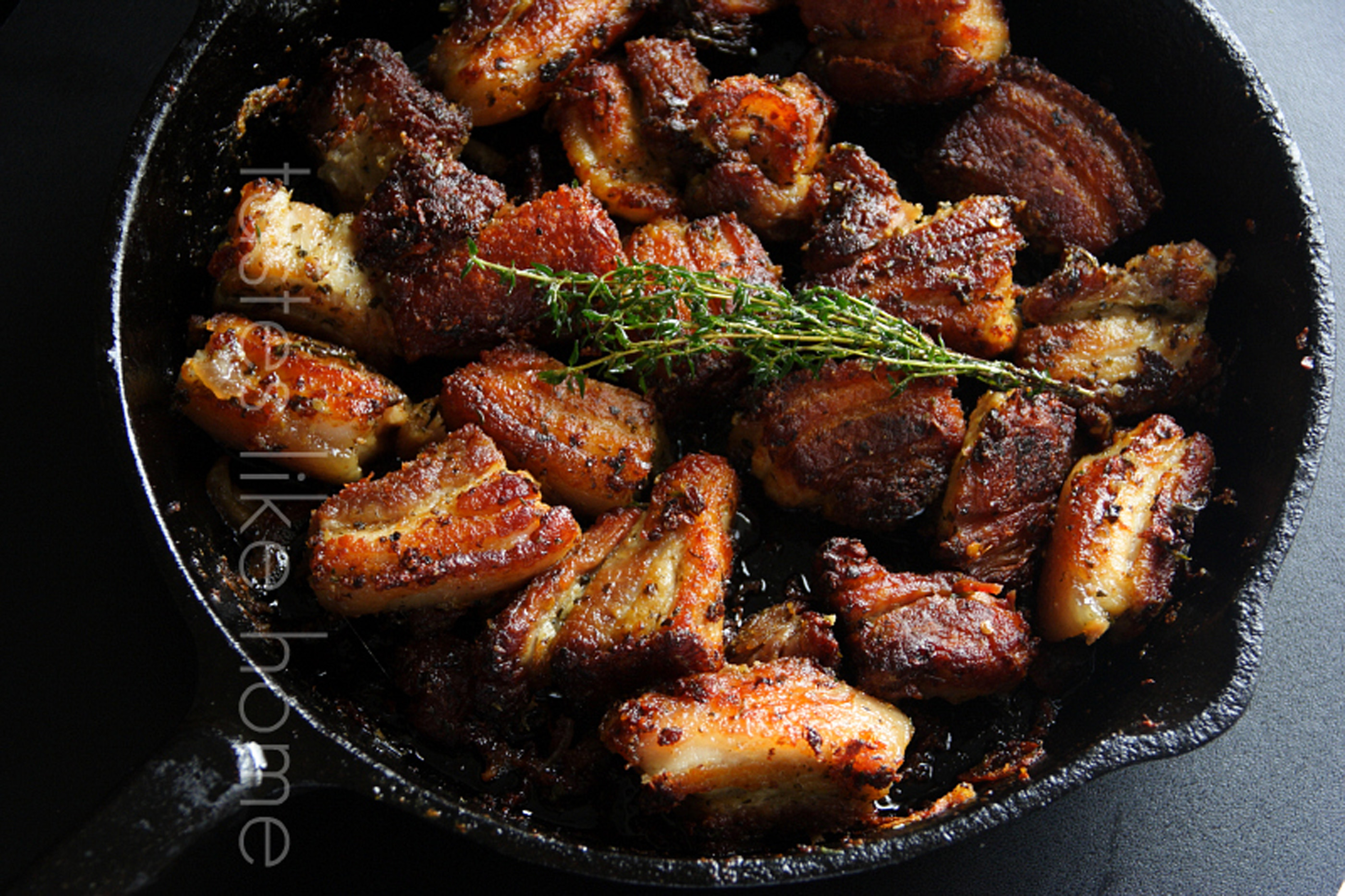The inspiration for my take on this garlicky-pork comes from Mexican cuisine. They make a meat dish called carnitas, which literally translates to “little meats”. With carnitas, the meat is cooked low and slow for a long period of time until it is so tender that it can be shredded with two forks, the meat is then pan fried and served by itself or with tortillas.

Here’s what you need to know to make it yourself. We’re cooking free style here, so go with the flow and trust your instincts.
The Meat
Start off with a fresh fatty piece of pork. You need fat in the meat for flavour, and, don’t worry, a lot of it gets cook
ed out. The ideal cut of meat for this dish would be the pork shoulder. A pig has four legs right? Well the two back legs are known as leg roasts, the meat there is more uniform and lean, the muscles there are not used much that is why they are ideal for hams and leg-roasts because they slice up perfectly. The legs also take less time to cook. You don’t want this. Ask the butcher for the cut of meat that comes from either of the two front legs of the pork. The meat here is marbled with fat, there are connective tissues and it is tougher; pork shoulder requires a longer period of time to cook. The two front legs are tougher because this is the part of the animal that is used and worked the most that is why it is tough. If you can’t get pork shoulder, then a second great option is the pork belly or pork flap. Ask the butcher for the pork belly or pork flap – this is the part that is used to make bacon. This cut has a good meat to fat ratio that is layered.
Cut the meat up into large chunks, say about 2 inches by 2 inches each. Pat the meat dry and set it aside in a large bowl or container or a large zip bag that you can then cover/zip and put into the fridge.

The Seasoning
The amount of seasoning you will use will depend
on how much pork
you are cooking. The ingredients are garlic, thyme, hot pepper, onions, fresh lime juice and salt. I’d say use one head of garlic to one
and a half pounds of pork. Grab lots of fresh thyme and some of that lovely wiri wiri pepper or the scotch bonnets (aka big pepper, hot pepper). You’ll
need salt to taste. If you can put your hand on some coarse sea salt use that instead of table salt. The only reason I am saying this is because the coarse sea salt will aid in the bruising of the ingredients as you grind everything together. But honestly, don’t fuss if you don’t have, regular table salt will work fine. Make sure that the lime juice is fresh, don’t use the bottled stuff as it can change the flavour profile. So as to use all of the lime, you can also grate the zest of the lime before cutting and squeezing the juice. Use one-tablespoon lime juice to one and half pounds of meat.
If you have a mortar and pestle like I do, put everything except the limejuice in the mortar and pound, mash and grind it to a paste. Stir in the lime juice until it is incorporated. Taste the seasoning, if necessary, add more salt depending on how tart the lime juice is. Think traditional garlic pork.
If you do not have a mortar and pestle, then add all the ingredients to a food processor and blend to a paste.
Pour the marinade all over the meat and rub it in well. You want each piece of meat to be coated with the seasoning. Cover, zip or seal the container/bag, place in a shallow dish and refrigerate overnight.
Cooking – Stage 1
Remove the container/bag with the meat from the refrigerator 30 – 45 minutes before you are ready to cook it. This is to bring it up to room temperature.
Empty the entire contents of the container/bag into an adequately sized pot, or, if you have one, a pressure cooker. If using a regular pot with a tight lid, add water – 2 cups of water per pound of meat. If using a pressure cooker, add 1 cup of water per pound of meat. Cover the pots and bring them up to a boil/pressure. When the pot comes to a boil, let cook on high heat for 5 minutes then reduce to low and let simmer until meat is cooked through and tender. If using a pressure cooker, pressure for 20 minutes on medium heat. Time starts from the first whistle.
When the meat is cooked, there may still be some liquid in the pots, remove the covers and let the meat continue to cook until the liquid has dried out.
Remove the meat from the pots and place them on a sheet pan and let cool for about 20 – 30 minutes. This is to air-dry the meat and aid in the crisping up in the second stage of cooking.
Cooking – Stage 2
What you’re going to do now is pan fry the meat until it browns and crisps up on the outside. This stage will result in an added texture to the meat – crisp on the outside, tender on the inside.
Do not use a karahi for this, use a shallow frying pan, you need as much surface area as you can get. If you have a cast iron skillet, it would be perfect for this job.
Drizzle in some oil into the pan to coat the bottom of the pan and let it heat up until it is very hot. Working in batches, add the meat to the pan and spread it out in a single layer. Let it fry for 1 – 2 minutes on one side before turning it. You want to ensure that it is crisp and browned before turning it. Keep a splatter cover nearby as the meat may pop and spit as a result of any residual liquid.
Repeat until all the meat is fried. Serve as the meat component of a meal or as a cutter. The aroma of this meat cooking is going to suck you in and have you salivating. When the first batch is fried, you will be hard pressed to resist the temptation of trying a piece, and you should, because, you know, you have to taste-test it yourself. And more importantly, make a huge batch because they will be asking for more.
So, if you’re looking for a garlic pork fix, then this is it.
Cynthia
Cynthia@tasteslikehome.org
www.tasteslikehome.org




